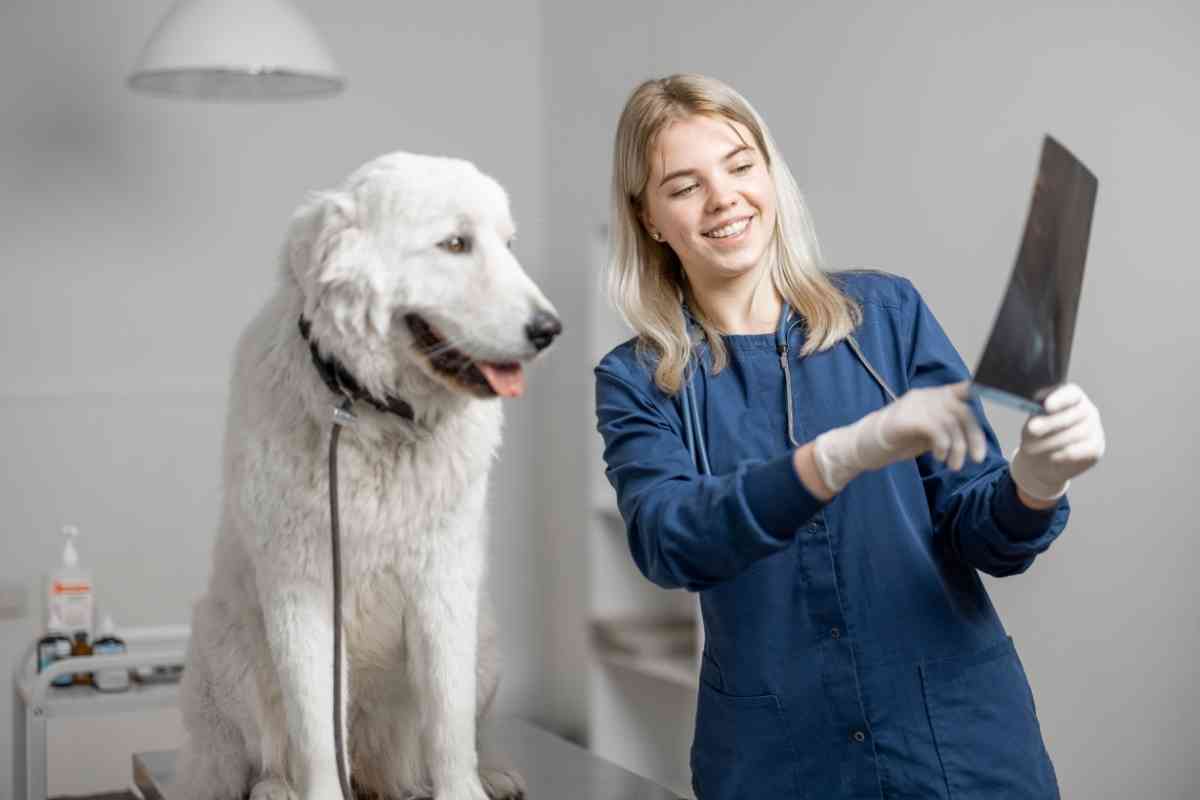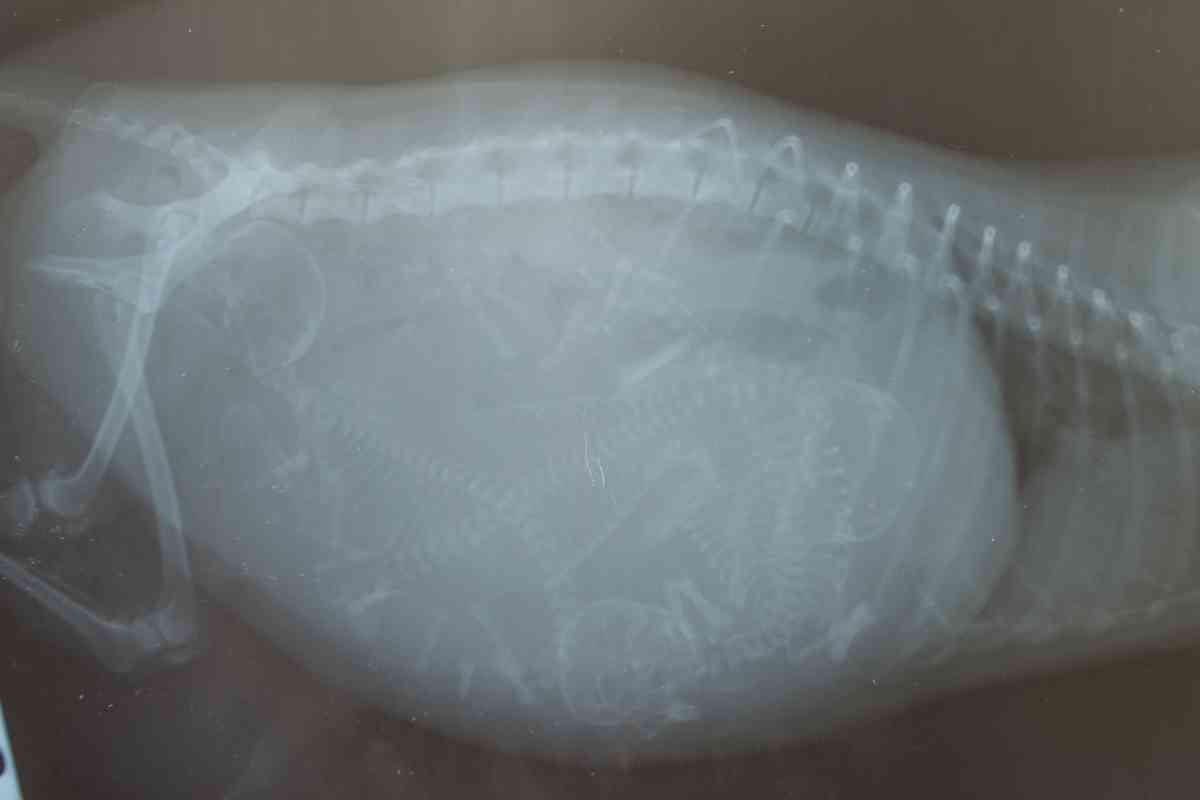How Accurate Is An X-Ray At Counting Puppies In A Litter?
Nothing matches the joy of having new pups. Preparing for the babies without knowing how many they are is challenging, but x-rays come in handy. When you know how many pups are on the way, preparing for them is easy and stress-free. The number of puppies affects the nursery and how many you’ll keep and give away. You can over- or under-prepare if you make assumptions about how many puppies to expect. But, how accurate is an x-ray for puppy count of litter size?

Are x-rays an accurate way to tell how many puppies a pregnant dog will have?
X-ray is the most accurate way to tell how many puppies your furry buddy will deliver. With X-rays you can often accurately count the litter. X-rays should be taken towards the end of the pregnancy since the fetus’s bones don’t calcify until about day 49 of gestation.
Waiting until almost day 55 will result in a more accurate x-ray scan. It would be challenging to determine an accurate number of fetuses if the photographs were taken before the skeletons began to calcify.
Before your pooch undergoes an X-ray, ensure you are well equipped with knowledge about the process to help you determine if this is an option you are willing to take.
Are X-Rays Accurate?
X-ray is the most accurate way to tell how many puppies your furry buddy will deliver. X-rays can often accurately count the litter since they can see the whole uterus simultaneously. The process normally takes place towards the end of the pregnancy since the fetus’s bones don’t calcify until about day 49 of gestation.
In light of this strategy, waiting until close to day 55 will yield a more precise x-ray. If the images are shot before the skeletons calcify, it would be difficult to get an exact count.
While X-rays are frequently precise, there are a few occasions where a few dogs have had a little more puppies than was initially thought. This is rather common, and it can happen if two puppies are stacked or superimposed in images to give the impression that only one exists.
Yet, if your clinicians discovered seven skulls and spines, but you only see six puppies, the canine isn’t done whelping.
Benefits of X-rays To A Pregnant Pooch
The benefits of an X-ray to dogs go beyond determining the number of puppies the furry buddy will deliver. The benefits include:
Indicate What Is Truly Happening To The Pup
Most times, it’s easy to confuse what is happening inside the buddy’s body since many conditions share symptoms. X-rays reveal whether a dog’s uterus is thickening, pregnant, or falsely pregnant.
Determine The Puppy’s Size
An x-ray is used to gauge a dog’s size. When a veterinarian examines the skulls on the x-ray, they can tell whether one or more puppies appear larger than the rest and whether the skull sizes appear out of proportion to the pelvic canal.
Determine The Means of Birth
Preparing for a canine’s delivery is paramount and is determined by the size of the litter. The womb is more crowded when the litter is big, meaning the puppies’ size is frequently smaller. Conversely, puppies will have more area to grow if the litter is smaller, resulting in bigger puppies.
Smaller puppies typically result in simpler delivery, while larger puppies might be more difficult to give birth to through the normal mode of delivery. For larger puppies, a C-section is necessary, but smaller puppies do not.

Detect Whether The Pup Developed Complications After Giving Birth
An x-ray is helpful if your pup has given birth but appears to be having trouble, and this helps the vet deal with the problem before it gets worse.
Show Whether The Pup Has Finished Whelping
An X-ray can detect a trapped puppy that could harm the mom and her unborn offspring. A puppy trapped in utero may be fatal to both the dam and the puppy.
Detect Dead or Malformed Puppies
Dead or malformed puppies may not always be visible on X-rays, but they frequently are when an experienced radiologist examines the images. This may require you to visit high-end experienced vets, though. If an issue is seen on the x-ray, the breeder and veterinarian can act immediately.
Are X-rays Safe For Dogs?
Yes, X-rays are safe for dogs; otherwise, vets wouldn’t widely recommend them. While using x-rays for dogs may be wrongly perceived as unsafe since radiation is involved, x-rays are often only used infrequently and are typically used as a screening
Your veterinarian will discuss the advantages and disadvantages unique to your dog’s condition so you can choose if you wish to have your dog get an x-ray. The process is painless, and the patient will have minimal radiation exposure. Usually, a calm, compliant pet will undergo the procedure swiftly.
X-ray Alternatives
If you have second thoughts about X-rays, here are other options you can explore:
Palpation
Ask the veterinarian to palpate her abdomen and determine the size of her litter if you cannot wait until the 28th day of her pregnancy. Only let a highly experienced vet palpate your pup because they are still very young, fragile, and still embryos. The vet should know where and how to do so without compromising the fetal-placental units.
Ultrasound
An ultrasound can take the place of an x-ray. As early as day 28 of the gestational cycle, ultrasounds can be used to determine whether a woman is pregnant. Even though it is a safe and non-invasive option, an x-ray is much more accurate at determining the size of the litter and the puppies.
Dog ultrasonography is inaccurate because only a small portion of the uterus is viewed in the scanning plane. As a result, fetuses may be counted multiple times or not at all.
Does The X-ray Require Sedation
Sedation is occasionally necessary, to get a legible x-ray. If your dog is relaxed, not in pain, and can lie comfortably while the x-ray is taken, the canine will not require sedation.
On the contrary, sedation may be advised if your dog is agitated, fearful, or in discomfort. Sedation may also be used during your dog’s x-ray to relax muscles and capture a crisp image.
Additional Benefits of X-Rays
X-rays are essential to dogs in many ways. They include:
Accelerate the Process of Accurately Detecting a Lesion
X-rays will speed the process of appropriately diagnosing an injury by giving exact images for therapy. X-rays will provide a high level of precision; it is secure and discreet.
Helps in Surgery Operations
Each surgeon conducts surgery with prudence. Surgery is a very mild form of treatment that demands extreme caution. Using X-rays, surgeons may diagnose the problem and take precautions.
Rule Out Medical Problems
If observation is not an option, your veterinarian will test your pet’s blood and urine to rule out any medical issues. However, when these are similarly ineffective, X-rays will be the veterinarian’s best diagnostic
Rapid and Straightforward Examination Process
A patient can have severe discomfort and take a while to be examined in various ways. The veterinarian will only need a short amount of time to take an X-ray to get an image that will inform the next step in the therapeutic process.
Offers a Wide Field of Vision
An X-ray provides a clear picture of any part of the body, including its surroundings, and provides a thorough understanding of whatever is happening inside the patient.